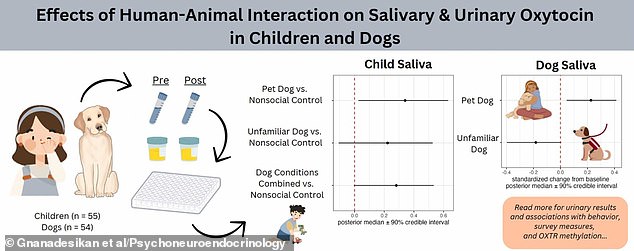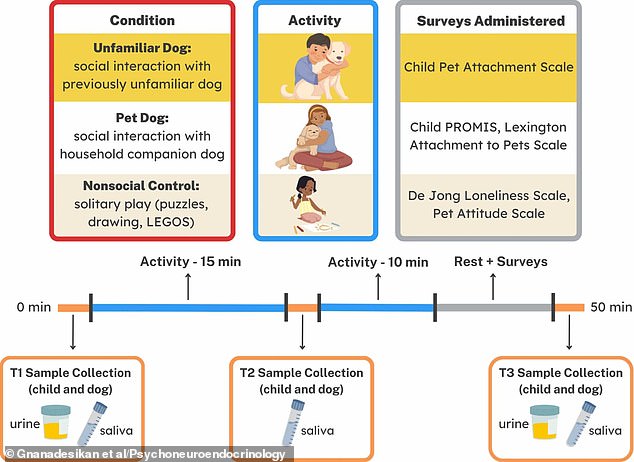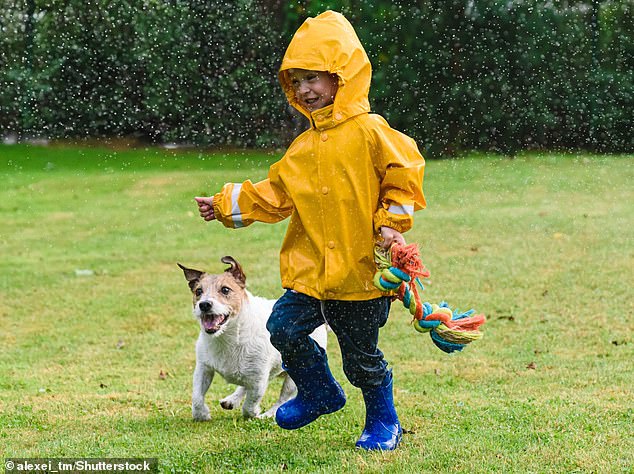- Oxytocin is the so-called “hug” or “love” hormone related to social bonds.
- READ MORE: The canine brain synchronizes with ours when we look into their eyes
Letting your child play with the family dog could be beneficial for both of you, a new study shows.
Scientists have discovered that children get a dose of a beneficial hormone called oxytocin after fun interactions with canines.
Oxytocin, which is produced in the hypothalamus of the brain and released into the bloodstream, is known to reduce stress and anxiety and help humans express their emotions.
The hormone was found in higher concentrations in children when they interacted with dogs, compared to those who played alone with toys and games.
Of course, as with any interaction between dogs and small people, owners must be aware of what is happening to avoid heartbreaking incidents.
Study suggests letting children play with a dog may be beneficial by increasing oxytocin, commonly known as the “love hormone” (file photo)

The new study reports on the stress-reducing benefits of the child-dog bond: an increase in oxytocin, the “love hormone,” which is associated with positive emotions, stress reduction and the formation of social bonds.
The new study was led by Gitanjali E. Gnanadesikan, a postdoctoral fellow in the school of anthropology at the University of Arizona in Tucson.
“To our knowledge, this study provides the first evidence of an effect of affiliative social interactions with dogs on oxytocin concentrations in children,” Gnanadesikan and colleagues state in their report. research workpublished in the journal Psycho-neuroendocrinology.
For the study, scientists recruited 55 children between the ages of 8 and 10 to conduct experiments at the Arizona Canine Cognition Center in Tucson.
During three different visits, the children played with their dog, with an unknown dog, and alone.
Before, during and after the three play sessions, oxytocin levels were recorded in both the dogs and the children, from saliva and urine samples.
After analyzing the results, Gnanadesikan and his colleagues found that interaction with dogs led to higher levels of oxytocin in children compared to solitary play.

Before, during and after the three play sessions, oxytocin levels were recorded in both dogs and children, from saliva and urine samples.
Both familiar and unfamiliar dog interactions had this oxytocin-boosting effect in children, the researchers report.
This suggests that it doesn’t matter whether children play with their own dog or someone else’s to get the beneficial hormonal boost.
As for the canines, domestic dogs showed increases in oxytocin in their saliva, while the team observed the opposite pattern in unfamiliar dogs.
Therefore, researchers believe that interactions with children can also stimulate the release of oxytocin in dogs, but only if the child is familiar to them.
The team admits that the interactions between children and dogs they observed in a laboratory “probably differ in important ways from those that occur in the home environment.”
“For example, it is unlikely that children or dogs would feel as comfortable in the unfamiliar environment of the laboratory as they normally would at home,” they state in their article.
The experts used 35 mixed breeds and 19 pure breeds for their study, although they did not specify the exact breed types.
But dog owners should always be very attentive to any breed in the presence of children in the home, especially babies and babies.
What’s more, the researchers used children between 8 and 10 years old, which is a relatively narrow age range.
Younger children with less ability to care for themselves are especially vulnerable in the presence of dogs, especially without adult supervision.
Blue Cross says: “Children and dogs should not be left alone without adult supervision.”

